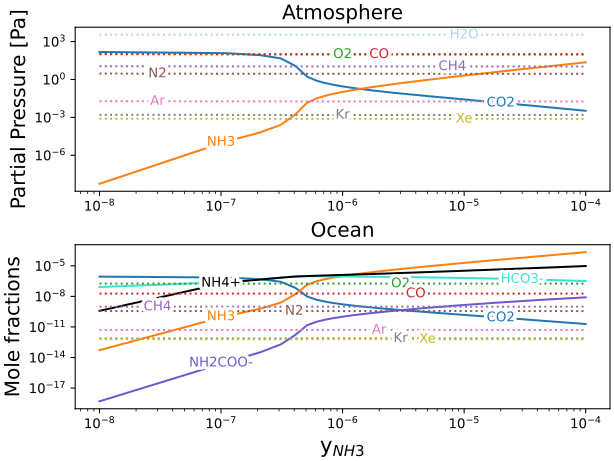- 1Aix-Marseille Université, CNRS, CNES, Institut Origines, LAM, Marseille (alizee.amsler@lam.fr)
- 2Aix-Marseille Université, CNRS, CNES, Institut Origines, LAM, Marseille, France (olivier.mousis@lam.fr)
- 3Institut Universitaire de France (IUF) (olivier.mousis@lam.fr)
- 4Aix-Marseille Université, CNRS, Institut Origines, PIIM, Marseille, France (alexis.BOUQUET@univ-amu.fr)
- 5Aix-Marseille Université, CNRS, CNES, Institut Origines, LAM, Marseille, France (alexis.BOUQUET@univ-amu.fr)
The question of the habitable environments within the Galilean moons is raised by the presence of hydrospheres in those worlds. The study of the current volatiles inventory on those moons is indicative of their formation processes and how they could affect this inventory. However, for the ability to disentangle between the possible scenarios, it is necessary to examine the post-accretion processes that could impact the volatile inventory of the hydrospheres. Especially, an “open-ocean” phase that occurred shortly after accretion, before the icy crust formation, must be considered, in view of its influence on the volatile inventory. More specifically, the abundance of ammonia in Europa’s building blocks is a key constrain, both on the habitability conditions of the ocean and the composition of the primordial thick atmosphere of the moon.
Our work focuses on modelling the ocean-atmosphere equilibrium which took place over this period, based on the type of material accreted by Europa at its formation. To do so, we compute the vapour-liquid equilibrium between water and volatiles, as well as the chemical equilibria happening within the ocean to model the primitive hydrosphere of Europa. Our model allows for an assessment of the impact of the initial distribution of volatiles resulting from the thermodynamic equilibrium between Europa’s primordial atmosphere and ocean. In particular, we show the correlation between the ratio of dissolved CO2 and NH3 and the distribution of partial pressures in the primordial atmosphere of Europa.

Fig1: Evolution at T = 300 K of the distribution of species in both the atmosphere and the ocean as a function of the mole fraction of initially NH3 incorporated into the atmosphere. All the other species’ initial mole fractions remain constant.
Navigating between different compositions of accreted material and varying the proportion of ammonia incorporated into the ocean after accretion, we obtain a range of primordial volatile distributions in the hydrosphere, to be linked to nowadays inventory. We also find ammonia abundance thresholds above which CO2 content is significantly depleted by NH2COO- formation (fig 1).
How to cite: Amsler Moulanier, A., Mousis, O., and Bouquet, A.: The influence of ammonia on the primordial distribution of volatiles in the hydrosphere of Europa, Europlanet Science Congress 2024, Berlin, Germany, 8–13 Sep 2024, EPSC2024-221, https://doi.org/10.5194/epsc2024-221, 2024.